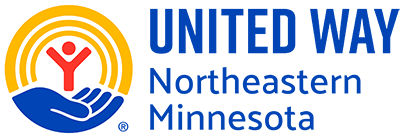While January is National Human Trafficking Prevention Month, our region is home to several agencies working year-round to prevent trafficking in our local communities.
“This is one of those issues that we know affects communities of every size – this is not just happening in big cities,” said United Way of Northeastern Minnesota (UWNEMN) Executive Director Erin Shay. “It’s one of the reasons UWNEMN is so proud to support local agencies that work to support survivors and unite against trafficking in our area.”
These agencies cover the entire region and confirm trafficking is happening in their community.
Minnesota Department of Human Services defines trafficking as “the use of force, fraud, or coercion to obtain some type of labor or commercial sex act.”
“A more common form of trafficking in our community consists of survival sex,” said Friends Against Abuse Executive Director Jenell Feller. “…someone trading sex for a safe place to sleep, food to eat, drugs, or transportation.”
Support Within Reach Executive Director Evett Ellis and Sexual Assault Program of North St. Louis County Executive Director Jeanne Olson concurred.
This form of trafficking may not be what usually comes to mind for most people, though Olson said instead of addressing the myths of trafficking, she prefers to “focus on the truths.”
“The falsehoods stick with people, and those falsehoods cause harm” she said, including the public missing warning signs.
***
So, what are the warning signs?
Warning signs can be difficult for youth because the same warning signs for trafficking could potentially be signs of depression or other issues, Ellis said.
“But usually a gap in school attendance…avoiding eye contact…if they lack control of their schedule, money, or proof of ID when they’re with an adult who is not their parent,” she continued. “If you notice basic needs not being met, that is the biggest red flag.”
Trafficking can happen to people of any age, but Ellis said ages 11-18 is a particularly high-risk group– and important to focus on for prevention.
People with learning disabilities, youth runaways, and individuals that have been isolated from their families are also at-risk, Olson added.
“Vulnerable people are the people being trafficked,” she said.
The true number of how many people in our communities are being trafficked – and what their backgrounds are – is typically difficult to determine.
“People don’t report because they are dependent on the person trafficking,” Feller said.
Victims of trafficking are often struggling with addiction, embarrassed, scared, or even blackmailed, Olson added.
“It’s very rare that a trafficking case gets charged,” she said. “Crisis calls are our main source of support, but they’re not often ongoing. Usually it’s one or two calls, and then they disappear.”
In the instance someone does move through the legal system, local agencies provide advocacy and counseling. They will often find other unique ways of supporting individuals to fit the circumstances as well.
“The needs of a victim that has been sex trafficked are great,” Feller said. “The physical and emotional trauma that they have suffered are hard to comprehend.
They often have nothing – no ID, no credit rating or a severely damaged one, they have no work skills or references. Their friends and families may not be supportive. They have to start with less than nothing.”
In addition, several local agencies provide additional resources for youth – like safe housing – through Minnesota Department of Health’s Safe Harbor system.
Minnesota’ Safe Harbor law went into effect in 2014 to increase awareness, understanding, and identification of sexual exploitation of youth and ensures that trafficked youth are not seen as criminals but as victims in need of services.
Support Within Reach is a Safe Harbor regional navigator for Northwest Minnesota; the Program for Aid to Victims of Sexual Assault in Duluth is the regional navigator for Northeast Minnesota.
“But if you call one of us, we will send you to the right one (group) no matter who you call,” said Ellis.
***
What can the public do to help prevent trafficking?
If you see something that seems off, report it to law enforcement, Feller advises.
“It seems simple and obvious, but don’t support prostitution,” she added. “…in Minnesota, other states, or other countries.”
Connect with the agencies in your community working on these issues, Ellis added.
“It’s OK not to be an expert,” she said. “You can send someone to the experts.”
Local agencies themselves work on prevention primarily through education, always tailored to be age appropriate – often focusing not on “trafficking” per se but on things like boundaries, social media use, etc.
“The best prevention is to build a person’s self-esteem and boundaries,” Ellis said. “…When you invite our organizations to present or support our organizations…that’s you helping us come up with a solution to end these things,” she said.
Donations to UWNEMN over the past year supported local agencies like Advocates for Family Peace, Friends Against Abuse, the Sexual Assault Program of Northern St. Louis County, and Support Within Reach.
For more information about these and other UWNEMN partner agencies, visit www.unitedwaynemn.org/partners. To connect with Safe Harbor resources for sexually exploited youth, call 1-866-233-1111.
***
If you need resources:
Advocates for Family Peace
Virginia: 218-248-5512
820 9th Street N
Serves North St. Louis County and Itasca County individuals.
Bois Forte Victim Services
Nett Lake: 218-757-3295
3071 Net Lake Road, Suite A
Serves Bois Forte Band.
Friends Against Abuse
International Falls: 218-285-7220
407 4th Street
Serves International Falls area individuals.
Program for Aid to Victims of Sexual Assault (PAVSA)
Duluth: 218-726-1931
32 East 1st Street, Suite 200
Safe Harbor Regional Navigator for Northeast Minnesota.
Sexual Assault Program of NSLC
Virginia: 218-749-4725
327 1st St. S, Suite 17
Serves individuals in North St. Louis County.
Support Within Reach
Grand Rapids: 218-326-5008
9 Willow Lane
Serves individuals in Itasca County; Safe Harbor Regional Navigator for Northwest Minnesota.
